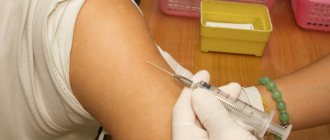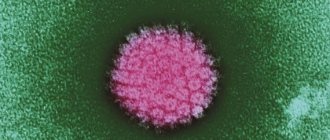What are the dangers of childhood infections?
The anti-vaccination hype in the media has been going on for two decades now, and the consequences of such publications are already producing results. Infections that were previously rare due to mass vaccination have begun to be recorded more and more frequently, including among children of all ages. Polio, measles, rubella, diphtheria - for many years doctors studied them only in theory, but today their outbreaks are no longer uncommon. The problem is that in children who do not yet have the physiological maturity of the immune system, these infections can cause complications, even lethal ones. Of course, the decision to vaccinate lies with the parents, but it is important that they make an informed decision, not based on emotions and intimidation by “horror stories,” but on the basis of the facts of knowledge about vaccinations and vaccinations.
Children under ten years of age usually suffer from measles, rubella infection or mumps. The peak incidence occurs during the period of senior preschool and primary school age. This is due to particularly active and extensive contacts with other children and adults who are carriers of viruses or suffer from these pathologies. They are dangerous both due to their severe course and serious complications from many organs and tissues. But it’s worth saying more specifically about the dangerous complications for each of them:
- Thus, measles, being one of the most contagious viral diseases among people, led to mass epidemics with the death of children or adults from dangerous and severe complications before the era of vaccinations. In terms of prevalence, measles occupied one of the leading places among infections in children of preschool and school age, often resulting in pneumonia or measles encephalitis, which threatens the death of the child. Against the background of today's initially unsatisfactory condition of many children and weakened immunity, a measles epidemic can cause a lot of trouble among modern children. It is no less dangerous for adults who do not have immunity to it, which needs to be “refreshed” every 10 years. During gestation, measles threatens miscarriages, stillbirths, or low birth weight babies with developmental delays.
- Mumps is not as contagious as measles, but is dangerous due to complications from the glandular organs, to which the virus has tropism. Up to 20% of cases of infection can lead to damage to the brain and its membranes, which can lead to encephalitis and meningitis, which can lead to a severe course and long-term hospitalization of the child. Mumps is dangerous for the reproductive system, especially in boys. Damage to the testicles with the development of orchitis threatens infertility and disruption of reproductive and intimate function in later life. Mumps can lead to the formation of otitis media, leading to hearing loss or deafness on one side or in both ears at once. The lesion can also affect the pancreas, thyroid, and ovaries in girls.
- Rubella has a relatively mild and favorable course and rarely causes complications, but not during pregnancy if the woman does not have antibodies to the virus. In this case, she is at risk of severe fetal malformations, especially if it is early gestation or congenital rubella syndrome in children, which leads to multiple serious lesions and long-term infectiousness of the baby to others.
To get the MMR vaccine or not?
There is a lot of controversy around whether it is worth vaccinating children with MMR vaccinations on the Internet and in real life. According to anecdotal evidence and the same undocumented statistical studies, vaccinations are attributed to neurological pathologies, side effects from the lungs, liver and kidneys. These data naturally worry parents, which leads to unfounded refusals of vaccinations. As a result, immunization from 95-92% at the end of the last century has decreased to 80-84% today. This threatens that if the percentage of immunized children decreases, outbreaks and epidemics of pathologies are possible. Many parents may believe that the risks of vaccinations may outweigh the dangers of the infections themselves, but it is worth knowing that measles kills up to 800 thousand people every year, most of them children .
These are countries that, due to poverty, do not allow themselves mass immunization. But these are forecasts for our country with a further expansion of anti-vaccination sentiment. Dr. Komarovsky talks about the need and importance of vaccination, including MMR vaccination:
Can a child get sick after immunization?
All types of vaccines used against measles, rubella and mumps contain exclusively attenuated strains of viruses. The virulence, or ability of a pathogenic microorganism to infect a vaccinated person, in this type of vaccination is practically zero.
After an injection, a child cannot get measles, rubella, or mumps. In rare cases and with a certain set of symptoms, experts note the development of a measles-like symptom, which resembles an infection, but occurs in a very mild form.
When to vaccinate MMR, where to vaccinate
For all vaccinations included in the national immunization calendar of the Russian Federation, there are strictly defined periods within which immunization is carried out. They are provided with vaccines free of charge at the expense of the state. The timing of immunization is chosen in such a way that immunity is formed as actively as possible and protects the child during those periods when he is most vulnerable to these pathologies. Due to this immunization scheme, intense and active immunity to three infections is created for periods of up to 10 years or more, with timely revaccination. According to the approved scheme, healthy babies are vaccinated at one year of age, and then vaccinated again to maintain immunity at six years of age . A two-time vaccination is necessary in order to form the most active and long-lasting, intense immunity possible, which can weaken with age. In addition, according to the plan, the vaccine will be administered at 15-17 years of age, then in the period from 22 to 29 years, then 32-39 years, repeated every decade.
Important
If a child has never been vaccinated with the MMR vaccine before reaching the age of 13, it is given for the first time at the age of 13, then vaccinations are carried out every 10 years. The vaccine is administered subcutaneously or intramuscularly. For children up to three years old, injections are used in the outer third of the thigh, and for older children - in the shoulder, in the deltoid muscle area.
It is important to immunize adolescents at any age, as well as adults if they have not had measles and are not vaccinated. This is due to the high morbidity among them and the severe course of the infection, frequent complications such as pneumonia and encephalitis.
Why do teenagers need MMR vaccination?
Often, vaccination against these three childhood infections (rubella, mumps and measles as part of the MMR vaccine) is offered to adolescents who have reached a certain age and have not previously received vaccinations due to health problems or parental refusal. Why such a practice at such an adult age? MMR vaccination gives excellent results in terms of further maintaining the health of young people, including reproductive health. Adolescents from 12-13 years of age to 15 and older are vaccinated. Protection against these three infections, including rubella, in girls is formed over the next 10 years, when the period of planning and having children occurs. And the rubella virus is most dangerous in the early stages of gestation for the fetus, and for a woman who has not been sick, this will be a great tragedy. Today, measles in adults has become not uncommon, and in them it is severe and with complications, and therefore the formation of immunity to measles for 10 years is no less important. For young men who have not had mumps, it is extremely important to protect themselves from it, because in adolescence and adulthood it causes complications in the testicles and prostate, leading to a sharp decrease in fertility up to irreversible infertility.
Thus, MMR vaccination in adolescents protects not only themselves from infection for a period of at least 10 years, but also the next generation, which they can give life to during these 10 safe years.
Interaction
Priorix can be administered simultaneously with DTP, ADS vaccines (on the same day), when injecting into different parts of the body with separate syringes. It is not allowed to use the same syringe with other drugs.
Priorix can be used for a second vaccination in persons previously vaccinated with mono drugs or with another combination vaccine.
special instructions
Use caution when administering to people with allergic diseases. The vaccinated person must stay for 30 minutes. under control.
The vaccination room must be provided with anti-shock therapy (adrenaline solution 1:1000). Before administering the vaccine, make sure that the alcohol has evaporated from the surface of the skin, as it can inactivate attenuated viruses in the vaccine.
Release form
Includes: 1 dose in a bottle, 0.5 ml solvent in an ampoule. Packing: cardboard boxes. 1 dose in a bottle + 0.5 ml solvent in a syringe, 1-2 needles.
For medical institutions: 100 bottles per box. Solvent separately, 100 ampoules. 10 doses per bottle. 50 bottles in a cardboard box. Separately, 5 ml solvent. 50 ampoules per box.
Shelf life and storage conditions
Two years is the shelf life of the vaccine, 5 years for the solvent. The expiration date is indicated on the packaging and bottle label.
Store at a temperature of 2 to 8°C. The solvent, packaged separately, is stored at temperatures from 2 to 25 ° C; Avoid freezing.
Conditions of release By prescription.
WE ADVISE YOU TO READ:
Havrix 720 and 1400 – an effective drug for preventing hepatitis A
Previous article
Which of the DTP vaccines available on the market is the best?
Next article
Vaccine options for these infections
Today there are enough vaccines that are highly effective and safe, despite the fact that they are live (weakened). They exist against all three infections - measles, rubella virus and mumps, and have sufficient experience in using them in practice for several decades. Often, when carrying out MMR vaccination, doctors additionally recommend adding the chickenpox vaccine to this complex for those who have not yet had it. In addition, vaccination options against these three infections can be combined with each other according to the epidemic situation and medical history (if any of the infections has already been suffered).
MMR vaccines are available in several versions; they contain various types of live, weakened components, which, without harming the body, create intense, very lasting immunity when administered. Modern vaccines do not contain “wild” viruses that lead to epidemics; they are all cultivated and, as experts call them, typed . That is, against the background of their safety for adults and children, they form active immunity, which protects against infections for a long time, without causing harm to the body. All vaccinations are compatible and interchangeable, so any of them can be used; they all have a high effect and degree of safety.
Vaccines are divided into:
- Three-component (all three infections included in one vaccine)
- Two-component (of the three infections in the vaccine there are only two - if one of them has already been suffered)
- Monocomponent (vaccine for each infection separately).
All drugs are considered interchangeable; if the drug with which vaccination was started is not available, you can easily replace it with a similar one (from a different manufacturer). This will not reduce the effectiveness or increase the risks of vaccination. All vaccines registered and used today for the prevention of measles, mumps or rubella infections meet all the strict requirements of international standards.
Three-component vaccines are ready for use; they contain three weakened viruses at once. These kinds of drugs are preferred due to the fact that in one visit and a single injection, immune protection is subsequently created against three diseases at once.
Two-component vaccines often contain combinations of measles with rubella or measles with mumps. If vaccination is carried out against three infections at once, they are supplemented with a second injection, and the missing third vaccine is administered. In this case, injections are given to distant (different) parts of the body; vaccines cannot be mixed with each other!
A monovaccine is a vaccination against only one infection with each injection. They are also not mixed in one injection, are injected into different parts of the body, and are usually used not for triple vaccination, but to protect against a specific disease.
Differences in vaccines
In addition to the number of vaccine components, drugs may differ by manufacturer - there are both domestic and imported drugs. According to research and observations of doctors, the drugs have approximately equal effectiveness and safety, so there are no significant differences in them. Registered on the territory of the Russian Federation:
- Domestic drug against rubella with a mumps component. It is classified as a live (attenuated) vaccine produced on quail eggs. In terms of safety and effectiveness, it actively competes with foreign analogues, but it has only two components; measles must be additionally administered with a second injection. This is its main inconvenience in relation to children, although for adults it is quite possible to use it as a revaccination. Immunity is created actively and sustainably for a period of up to 10 years or more.
- Imported drugs against all three infections (trivaccine), one syringe contains three components that protect against infections, weakened live viruses. At the same time, with just one injection, intense immunity is created against three diseases, which is why this drug compares favorably with the domestic one with its two components. For children, this means reduced stress from injections and convenience. The effectiveness is approximately the same for imported and domestic drugs, as well as the likelihood of side effects with complications.
note
The big disadvantage of such vaccines is their price, since commercial clinics provide vaccinations for a fee, and not all regions purchase these drugs in clinics for immunization of children as part of the national calendar.
Imported vaccines that are registered and applicable in our country are Priorix produced in Belgium and MMR-II (produced in the USA). Regarding MMR-II, more data has been accumulated on its use in the Russian Federation, since it became available to doctors earlier, but Priorix has also proven itself to be good over the years of its use.
The use of these vaccines, according to research, forms antibodies to measles in 98% of children or adults, to mumps in up to 96%, and for rubella even up to 99%. A year later, the level of antibodies remains at the proper level in all vaccinated people, which makes these vaccines effective and reliable. On average, protection lasts up to 6-10 years. The vaccines are compatible with other vaccinations:
- On the same day with them (but in different injections) you can give DPT or polio.
- The vaccine is compatible with vaccination against Haemophilus influenzae or chickenpox
However, they are all administered at two different points, in separate syringes; vaccinations cannot be mixed with each other. With any other live drugs, a difference of at least 30 days must be maintained.
For MMR-II, there are a number of restrictions and contraindications that must be remembered. Thus, MMR-II is not applicable when:
- Individual intolerance to chicken egg proteins
- Allergic reactions to aminoglycosides (in particular neomycin)
- When identifying primary and secondary immunodeficiency conditions
- Against the background of acute pathologies, or during exacerbation of existing chronic diseases
- During gestation in any trimester.
The Priorix vaccine is also registered in our country today and is used for vaccination against these three infections. It is highly purified, produces a minimal number of mild side effects, and is used for both adults and children. The degree of immunity intensity is comparable to MMR-II. But for Priorix there are also contraindications to its use:
- Individual intolerance to chicken egg proteins
- Allergic reactions to aminoglycosides (in particular neomycin) - skin reactions, respiratory phenomena
- When identifying primary and secondary immunodeficiency conditions
- Against the background of acute pathologies, or during exacerbation of existing chronic diseases
- During gestation in any trimester.
In all other cases, its introduction is carried out according to the National Calendar plan or individual indications.
MMR vaccination: instructions for use of the drug "Priorix"
A multicomponent vaccine is better because it needs to be injected once. Priorix can be given subcutaneously (under the shoulder blade) and up to 3 years - intramuscularly (into the thigh), after which - into the deltoid muscle of the shoulder (into the arm). A vaccinated person is not contagious to others.
Medicine form: lyophilisate for solution.
Its composition (from the instructions): Priorix - a combined drug containing attenuated strains of measles, mumps and rubella viruses, separately cultivated in chicken embryo cells.
A vaccine dose contains 3.5 lgTCD50 of measles virus strain Schwartz, 4.3 lgTCD50 of live mumps virus strain RIT4385, 3.5 lgTCD50 of rubella (vaccine strain Wistar RA 27/3). The vaccine contains 25 mcg of neomycin sulfate, sorbitol, lactose, mannitol, amino acids.
Description of the vaccine A homogeneous porous mass of white or slightly pink color. Its solvent is a colorless, transparent liquid, odorless and impurity-free.
Immunology Clinical trials have shown the vaccine to be highly effective. Antibodies to the mumps virus were found in 96.1%, measles - in 98% of vaccinated people, rubella - in 99.3%.
Purpose: Development of immunity, prevention of mumps, rubella, measles.
Mode of application
The contents with the solvent are added to the bottle with the dry preparation at the rate of 0.5 ml per 1 dose. Shake thoroughly until the mixture is completely dissolved, no more than 1 minute.
How to prepare for MMR vaccination?
No special measures are required to prepare for vaccination for healthy children or adults; vaccinations against measles, mumps and rubella infections are usually well tolerated. Only one condition will be important, which should be strictly observed - at the time of vaccination there should be no respiratory manifestations, exacerbations of chronic pathologies and other health problems. At least two weeks should pass from the moment of a cold or exacerbation of any chronic pathologies.
When it comes to special groups of patients, special approaches to vaccination may be required to reduce the risk of negative outcomes and various reactions to drug administration. For children prone to allergic reactions, it is worth consulting with an allergist and starting taking antihistamines three days before the injection. They are taken on the day of the injection and then for another three days after.
For children with various lesions of the nervous system (not related to contraindications for vaccination) or in the presence of chronic somatic pathology for the period of possible post-vaccination reactions, up to the 14th day from the moment of injection, therapy is carried out that prevents exacerbation of possible pathologies.
If a child belongs to the category of frequently ill people, is weakened or prone to frequent colds, infectious lesions of the respiratory system or exacerbations of chronic infections of the nasopharynx (adenoiditis, sinusitis, otitis), the doctor may recommend special therapy. It begins three days before vaccination and then for a period of two weeks after the introduction of the vaccine.
Important
Three days before vaccination, on the day of vaccination and after it, at least for the first 3-4 days, you should avoid contact with sick people who show signs of respiratory lesions. The child needs to be monitored for two weeks from the moment the vaccine is administered. It is important to refrain from visiting crowded places, shops and establishments where there are a lot of people on vaccination days. It is worth refusing to start visiting child care institutions for at least a week (if the child has already gone to kindergarten before, you can safely continue visiting). This helps reduce the risks of complications and negative reactions to a minimum.
What to do to avoid consequences in the post-vaccination period?
There are relatively few rules of behavior after vaccination:
- do not leave the clinic area for half an hour after the injection, trying to avoid being in a room with a large number of people. It is better to spend the indicated time outside. It is during this period that the risk of developing anaphylactic reactions to the vaccine is highest;
- under favorable weather conditions, do not sit at home, but go for a walk in the fresh air;
- It is permissible to swim after immunization, but not in the bath, but in the shower. It is better to put aside sponges and washcloths so as not to accidentally rub the injection site;
- refuse new foods and dishes for at least a week, so as not to provoke allergic reactions;
- try to avoid contact with people - to do this, you should avoid visiting cafes, cinemas, shopping malls, shops and other similar places.
And of course, you should carefully study the list of contraindications in advance, and if you suspect their presence, inform your doctor about it. Parents often think about whether to vaccinate their child with a domestic vaccine or give preference to a foreign one (Priorix, MMR2, etc.).
Priorix vaccine
Assessing the opinion of experts, as well as studying the reviews of mothers, allows us to assert that both Russian and foreign drugs have the same effectiveness and frequency of adverse reactions. The domestic vaccination is less convenient only because you have to give two injections in different parts of the body (there is no three-component vaccine).
List of contraindications for PDAs
Like many other types of vaccinations, vaccination against measles, rubella and mumps infections also has its contraindications to its use. You can also, like everyone else, divide them into two large groups - temporary or permanent. It is important to take this fact into account when deciding on vaccination, so that there are no complications or serious side effects. If we are talking about temporary contraindications, we partially touched on them above:
- Acute respiratory and other infections
- Periods of exacerbation for chronic pathologies, infections, various types of metabolic failures until they go into remission or stabilize their condition
- Pregnancy for a woman
- The use of blood products or blood transfusions, the use of gamma globulins in the treatment (vaccinations are postponed for a month from the date of use)
- Vaccination against tuberculosis, Mantoux or Diaskin test.
The formation of immunity when a live vaccine (especially against measles) is administered may be interfered with by recent tests performed to detect tuberculosis or vaccination against it. Therefore, between these two processes it is necessary to wait at least 4-6 weeks. Vaccination can distort test results, creating false-positive tests, but it does not have a negative effect on the course of the tuberculosis infection itself.
If we talk about permanent contraindications to the administration of MMR vaccines, these include:
- Previously identified allergic reactions to antibiotics (gentamicin or neomycin)
- Detected intolerance to chicken (or quail) egg protein, based on the type of vaccine
- Indication of a history of anaphylactic reactions (shock, angioedema, generalized urticaria)
- Oncological pathologies, progressive neoplasms, cancerous tumors
- Serious reactions to previous MMR vaccinations
- A sharp decrease in platelet levels in a blood test
- Immunodeficiencies, immunosuppression after transplantation, chemotherapy.
Acceptable reactions to PDA
During vaccination, some reactions may occur that are quite expected and predictable, as well as side effects, the presence of which must be known in advance . You should expect reactions in the period from 5 to 15 days; they are classified as delayed reactions, based on the fact that the vaccine contains live and weakened viruses of three (or two) infections at once. After they are introduced into the body of people who are immunized, they are activated and give an imitation of infection in order to form immunity. The peak of virus activity occurs precisely during this period, which gives reason to expect certain reactions at this time. This is a completely normal immune process, thus activating the synthesis of specific antibodies.
The most common effects and side effects of the vaccine are:
- Inflammatory reactions in the injection area - pain and compaction, infiltration at the injection site and tissue swelling. A similar reaction can develop on the first day after the vaccine is administered; it goes away on its own within a couple of days, no action needs to be taken.
- the formation of fever in 10-20% of children, especially with the introduction of trivaccine. Usually this reaction is typical for the measles component. Usually the fever is low, which is completely normal. It is permissible to increase it to 39.0 C; it occurs in the period from 5 to 15 days from the moment of drug administration. The reaction lasts up to a couple of days, and generally does not last more than 5 days.
- against the background of high fever, infants may experience convulsions that are not related to any pathology, but are related to the consequences of febrile reactions. They are provoked only against the background of fever and if it is more than 38.0 C. Such reactions are rare and do not have negative consequences for child health in the future. An elevated temperature is a completely normal immune process and should not be brought down. If necessary, you can use conventional antipyretics in syrups or suppositories to combat fever.
- When the vaccine is administered, a cough with a sore throat sensation may occur in the first few days, which does not require treatment or concern and goes away without any action. A mild rash may form on the skin of the body or in the area of certain surfaces (behind the ear, neck, face, arms and back, buttocks). The elements are small in size, difficult to distinguish from the skin, pale pink in color, and not raised. Such rashes are not dangerous and do not need to be treated with anything.
All the reactions described above are an imitation of infection and completely normal reactions of the body to the introduction of weakened viruses. People with such reactions are not dangerous or contagious, and the virus does not spread . The lymph nodes in the area behind the ear may become slightly enlarged - this is a reaction to the administration of the mumps vaccine components. This swelling is not dangerous, not painful and goes away on its own.
Possible consequences
Since the MMR vaccine contains several pathogens of viral diseases, the baby may experience adverse reactions . Typically, the consequences of vaccination are expressed in a violent response of the immune system. Unpleasant reactions disappear within 5 days and do not worsen the quality of life of the little patient. Normally, the following consequences can be observed:
- pain at the injection site;
- compaction and slight swelling in the area where the drug was administered;
- weakness and drowsiness;
- increased body temperature;
- loss of appetite;
- small rash on the body;
- enlargement of the parotid glands and lymph nodes.
Side effects, complications of CCP
Quite serious and health-threatening complications are possible when administering the MMR vaccine to special groups of children (less often, adults). It is possible to develop allergic reactions to the components of the administered drug, especially if the child has an allergic mood, reactions to antibiotics of the aminoglycoside group or to egg whites. This is a high-risk group for developing negative reactions to the vaccine. If you administer the drug without taking into account possible contraindications, you may develop urticaria, Quincke's edema, or the most dangerous complication - anaphylactic shock. This is especially dangerous for allergy sufferers; for ordinary people the risk is low.
Pain in the joint area with swelling may develop, which is more typical for adulthood; the older the age of the vaccinated, the more often such reactions occur. After 25 years, they are typical for 30% of vaccinated people, women suffer more often, pain is possible for up to three weeks, but they are not dangerous or severe, and do not interfere with normal life. Most often they are caused by the rubella component; such reactions are typical even for mono-vaccination against rubella.
A special complication may also occur - idiopathic thrombocytopenic purpura, a complication typical of 1 case per 23 thousand vaccine administrations . This threatens coagulation disorders in rare cases. In this case, blood platelets decrease sharply, which forms bruises on the skin that spread throughout the body. Bleeding from the nose or micro-hemorrhages on the skin, similar to needle pricks, are typical; they do not swell and disappear quickly and without a trace. Against the backdrop of the development of infections themselves, such a complication develops very actively and strongly.
Such complications are usually reversible; the reactions reflect the formation of active immunity in the area of the immunized body. This is a reaction to the introduction of weakened viruses. Such reactions (with the exception of allergies and purpura) do not require treatment; after a few days they disappear without a trace.
Alena Paretskaya, pediatrician, medical columnist
12, total, today
( 63 votes, average: 4.71 out of 5)
Dog bite to a person: risks and prevention of rabies
Coxsackie virus, Coxsackie epidemic in Turkey 2021: transmission routes, symptoms, treatment and prevention











